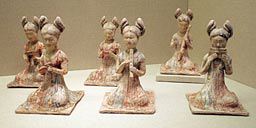Lesson Plan: Music of the Silk Road

Name: Abby Burgett
School: Stone Scholastic Academy
Subject Area(s): Music, Social Studies, and Language Arts
Grade Level: Fifth Grade
State Goals
- 25.A.2c Music: Identify elements and expressive qualities such as tone color, harmony, melody, form (rondo, theme and variation), rhythm/meter and dynamics in a variety of musical styles.
- 25.B.2: Understand how elements and principles combine within an art form to express ideas.
- 26.A.2c Music: Classify musical sound sources into groups (e.g., instrumental families, vocal ranges, solo/ensembles).
- 26.A.2d Music: Read and interpret the traditional music notation of note values and letter names.
- 27.A.2a: Identify and describe the relationship between the arts and various environments (e.g., home, school, workplace, theatre, gallery).
- 27.B.2: Identify and describe how the arts communicate the similarities and differences among various people, places and times.
- Language Arts SG 4: Listen and speak effectively in a variety of situations.
- Social Studies SG 16: Understand and analyze events, trends, individuals and movements shaping the history of other nations.
Objectives
Students will:
- Learn that music and musical instruments evolve over time and that their use spreads beyond their land of origin.
- Explore the sounds of Silk Road instruments and find ways in which they are similar and different to instruments we are familiar with today.
- Explain the role that instruments played in the interaction of people and cultures.
Materials/Resources/Gallery Objects
- Silk Road Instruments CD with audio clips of five instruments (comes with the SPICE Curriculum Guide Along the Silk Road)
- Large picture cards of each instrument
- Overhead copies of each instrument
- Musical Passport worksheet
- Individual instrument picture cards
- Overhead projector
- CD player
- Silk Road map
Procedures
- Pass out a Music Passport to each student; have them put it aside as you begin the next step.
- Turn lights out and begin by setting the scene for a night along the Silk Road. Describe the sounds, smells, feelings, tastes, and sights that would be experienced while traveling or stopping along the Silk Road. Slowly raise the lights as the “sun rises over the Silk Road.”
- Have students take out their Music Passport worksheet. Explain that they will be hearing 5 audio clips of musical instruments that would have been heard along the Silk Road. As they first listen to each clip, have students draw a picture showing what they feel and hear. On the second listening, have them attempt to draw what they think the instrument looks like. Are there strings? Does it look like a drum? Do you blow into it? What is it made of?
- Play each of the following clips two times:
a. Morin khuur
b. Qanun
c. Pipa
d. Daira
e. Shakuhachi - As students are making observations and hypotheses, circulate around the room to monitor listening and participation.
- Once students have completed each of the 5 sets of drawings, ask for volunteers to share what they drew and make sure to have them give back-up reasons or evidence as to why the drew what they did. Demand that students go deeper into their thinking by asking what instrument we have today that might be similar.
- As you place the first overhead image on the projector to show the first Silk Road instrument, have a student volunteer hold up the large picture card for closer viewing. Play the clip of the instrument #1 as you give background about the instrument. Continue this until all five instruments are revealed.
- Ask for questions at this time and allow for discussion in pairs.
- Distribute one instrument card to each student. Tell the class that by finding similar instruments held by other students, they will become part of one of 5 large groups.
- Allow students about 8 minutes to assemble in their groups.
- Discuss each grouping.
